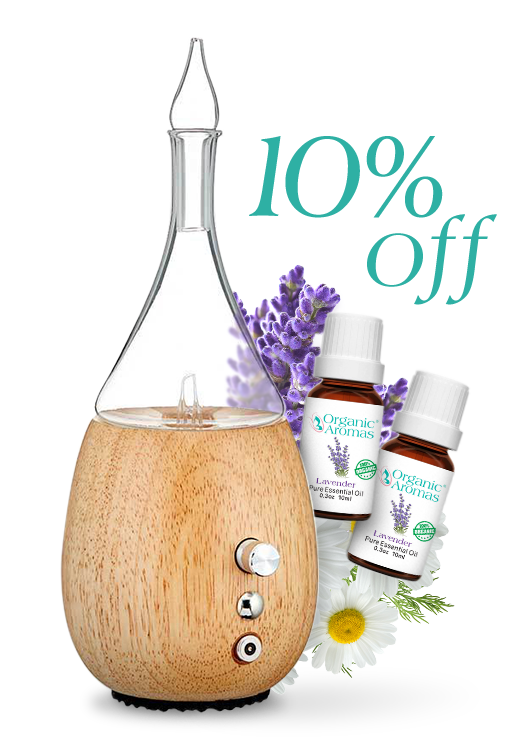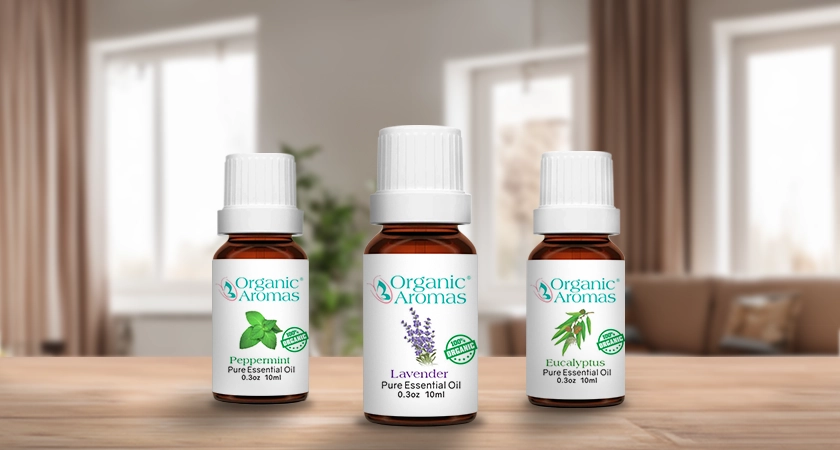Best Essential Oils for Migraines and Headaches
Headaches and migraines are all too common, disrupting daily life and causing immense discomfort. But what if relief is closer than you think? Essential oils, derived from natural sources, have been used for centuries to alleviate various ailments, including headaches. This comprehensive guide will help you discover the best essential oils for migraines and headaches, along with tips on how to apply them safely and effectively. So, let’s embark on this aromatic journey to a more pain-free existence.
Key Takeaways
- The top essential oils for headache relief include Peppermint, Lavender, Rosemary, Eucalyptus and Chamomile.
- Additional Essential Oils such as Ginger, Frankincense and Geranium offer additional support in alleviating migraine symptoms.
- Natural complementary therapies like heat/cold therapy & acupressure combined with herbal teas/supplements can provide holistic relief from headaches.
Top Essential Oils for Headache Relief
There’s a whole world of essential oils out there, each with its unique properties and benefits. When it comes to headaches, some truly stand out from the rest. The top essential oils for headaches relief include:
- Peppermint
- Lavender
- Rosemary
- Eucalyptus
- Chamomile
These oils have been found to be particularly effective in easing various types of headaches, from tension and sinus headaches to migraine headache attacks.
We will now examine the unique characteristics of each of these potent oils.
Peppermint: Cooling and Pain-Relieving
Peppermint oil is prized for its cooling and pain-relieving properties, making it a popular choice for headaches. Its active ingredient, menthol, helps relax muscles and stimulate blood flow, which can alleviate tension headaches and sinus tension.
In a study conducted in 1996, participants experienced significant headache relief after applying diluted peppermint oil topically, proving its effectiveness as a natural remedy.
Lavender: Calming and Stress-Reducing
Lavender oil is well-known for its calming and stress-reducing effects, which can be especially helpful in managing headache symptoms. A placebo-controlled clinical trial demonstrated the efficacy of lavender essential oil in treating migraine headaches, with participants reporting significant relief after inhaling lavender oil.
As a natural sedative and relaxant, lavender oil can also promote better sleep, further reducing headache triggers.
Rosemary: Anti-Inflammatory and Circulation-Boosting
Rosemary oil offers a multitude of benefits for headache relief, including:
- Anti-inflammatory properties
- Circulation-enhancing properties
- Effectiveness in relieving tension headaches
- Ability to alleviate anxiety and depression
However, it’s important to be cautious when using rosemary oil, as it can cause contact dermatitis in some individuals.
Eucalyptus: Decongestant and Sinus-Clearing
Eucalyptus oil is a powerful decongestant and sinus-clearing agent, making it an excellent choice for those suffering from sinus headaches. Its ability to reduce sinus pressure, detoxify the body, and foster emotional stability can provide significant relief.
To make the most of eucalyptus oil, combine it with a carrier oil. Rub this combination onto the chest, back of the neck, temples, and forehead for maximum benefit.
Chamomile: Relaxing and Anti-Inflammatory
Chamomile oil is a gentle yet powerful essential oil that can help reduce headache pain with its relaxing and anti-inflammatory properties. It’s especially effective for tension headaches and can also help alleviate anxiety and insomnia, which are often associated with headaches.
However, pregnant individuals should avoid using chamomile essential oil for headache relief.

Additional Essential Oils for Migraine Support
While the top essential oils for headache relief have been discussed, there are additional oils that can provide migraine support. These include ginger, frankincense, and geranium, each with its unique properties and benefits.
We shall now investigate the ways in which these oils can alleviate migraine symptoms and provide further assistance to those suffering from migraines.


Join Our Exclusive Member Club to get Big Discounts!
Ginger: Nausea Reduction and Anti-Inflammatory
Ginger oil is known for its nausea reduction and anti-inflammatory properties, making it a helpful ally for migraine sufferers. The active ingredients in ginger oil, gingerols, and shogaols, contribute to these effects, providing relief from nausea and inflammation.
Topical application of ginger essential oil, diluted with a carrier oil, can help reduce headache pain and promote relaxation.
Frankincense: Grounding and Stress-Relieving
Frankincense oil offers grounding and stress-relieving benefits, which can aid in alleviating migraine symptoms. Its active components, α-pinene and other chemical compounds, provide relaxation and stress relief, making it a valuable essential oil for migraine support.
Topical application of diluted frankincense oil can help reduce headache symptoms and promote relaxation.
Geranium: Hormonal Balance and Menopausal Support
Geranium oil can help with hormonal headaches by:
- Balancing hormones
- Providing menopausal support
- Managing hormonal changes
- Improving mood
Research suggests that geranium oil may help relieve migraine symptoms by providing relief from hormonal changes and improving mood.
Inhaling one to two drops of geranium oil from a napkin can help benefit from its potential effects.
How to Apply Essential Oils for Headache Relief
Now that we’ve explored the best essential oils for headache relief and migraine support, it’s important to understand how to apply them effectively. There are various methods of using essential oils, including topical application, aromatherapy, and DIY blends. Each method has its unique benefits and can provide targeted relief for different headache types and symptoms.
We will now examine these techniques more closely.

Join Now and Get a Coupon for 10% Off!
Topical Application: Dilution and Massage Techniques
Topical application involves diluting essential oils with a carrier oil, such as jojoba oil or olive oil, and using massage techniques to apply them to the affected area. This method allows the oils to be absorbed directly into the skin, providing targeted relief for headache symptoms. Diluting essential oils prior to skin application is vital, as direct application could lead to irritation and other adverse reactions.
Aromatherapy: Diffusers and Inhalers
Aromatherapy involves using diffusers and inhalers to disperse essential oils into the air for inhalation. Diffusers come in various types, such as:
- Ultrasonic diffusers
- Heat diffusers
- Evaporative diffusers
- Nebulizing diffusers
These options allow you to choose the best option for your needs.
Inhalers, on the other hand, offer a more direct method of inhaling essential oils, providing quick relief for headache symptoms.
DIY Blends: Creating Customized Oil Combinations
DIY blends allow you to create customized oil combinations tailored to your specific headache types and symptoms. By combining oils such as:
- peppermint
- lavender
- eucalyptus
- rosemary
You can create blends that target tension, sinus, stress, or hormonal headaches, and even help relieve sinus tension.
Experimenting with different oil combinations can help you find the perfect blend for your needs, providing targeted relief and support for various headache symptoms.
Safety Guidelines for Essential Oil Use
Although essential oils can be a potent tool in the fight against headaches and migraines, using them safely is paramount. This section will provide safety guidelines for essential oil use, including dilution and patch testing, pregnancy and breastfeeding considerations, and quality assurance.
Adhering to these guidelines will ensure that you use essential oils for headache relief both safely and effectively.

Sign Up to Get Your FREE
e-Book Here…
Dilution and Patch Testing
Diluting essential oils with a carrier oil and conducting a patch test before applying them to larger areas of the skin are crucial steps to ensure the safe use of essential oils. A typical dilution ratio for essential oils is 1-2% or 1-2 drops of essential oil per teaspoon of carrier oil.
Conducting a patch test involves applying a few drops of the diluted oil to a small area of skin and waiting 48 hours to see if any irritation occurs.
Pregnancy and Breastfeeding Considerations
Pregnant and breastfeeding individuals should exercise caution when using essential oils and consult with a healthcare professional before incorporating them into their routine. Certain essential oils, such as oregano, cinnamon bark, jasmine, lemongrass, and ylang-ylang, should be avoided during pregnancy, while others like lavender, rose, peppermint, chamomile, lemon, and geranium are generally considered safe.
Quality Assurance and Trusted Brands
Quality assurance involves researching trusted brands and ensuring the essential oils are pure and properly stored. Organic Aromas is a trusted essential oils brand when looking for pure oils loaded with therapeutic benefits.
Natural Complementary Therapies for Headaches

In addition to essential oils, there are various natural complementary therapies that can provide relief from headaches. These therapies include heat and cold therapy, acupressure and reflexology, and herbal teas and supplements.
Combining these therapies with essential oils allows for a comprehensive strategy to alleviate headaches and enhance overall well-being.
Heat and Cold Therapy
Heat and cold therapy can help alleviate headache pain by relaxing muscles and reducing inflammation. Applying heat, such as a warm compress or heating pad, can increase circulation and blood flow to the affected area, helping to relax muscles and reduce tension.
Cold therapy, on the other hand, can help reduce inflammation and decrease blood flow, providing a numbing effect that can help alleviate pain.
Acupressure and Reflexology
Acupressure and reflexology techniques can provide relief from headaches by targeting specific pressure points on the body. Applying firm pressure to these points, such as the third eye, drilling bamboo, gates of consciousness, shoulder well, union valley, and the space between the base of the thumb and index finger, can help reduce eyestrain, sinus pressure, and migraine symptoms.
Herbal Teas and Supplements
Herbal teas and supplements can offer additional support for headache relief, working in conjunction with essential oils. Ginger, chamomile, and lavender are known to be effective herbal teas for relieving headaches, as they possess anti-inflammatory and calming properties that can help reduce pain and tension.
Additionally, supplements like Vitamin B2, Magnesium, Vitamin D, Coenzyme Q10, and melatonin can help support overall headache relief.
Summary
Essential oils can be a powerful and natural way to alleviate headaches and migraines. By understanding the properties of various oils, such as peppermint, lavender, rosemary, eucalyptus, and chamomile, and learning how to apply them effectively, you can find relief from headache pain and enjoy a more balanced and pain-free life. Additionally, incorporating complementary therapies like heat and cold therapy, acupressure and reflexology, and herbal teas and supplements can further enhance your headache relief toolkit. So, why not give these natural remedies a try and take control of your headaches today?
Frequently Asked Questions
What essentials oils help with continuous migraines?
For relieving migraine pain and symptoms, lavender essential oil is a popular choice due to its sedative and calming properties. Other beneficial scents for reducing headache symptoms include peppermint, rosemary, chamomile, eucalyptus and frankincense, while lavender and ginger may help with migraines specifically. Eucalyptus is great for sinus headaches, frankincense for cluster headaches, and geranium can help with hormonal headaches.
Is lavender or peppermint oil better for migraines?
Overall, lavender oil seems to be the better choice for managing migraines, as it has been found in studies to help alleviate migraine symptoms and provide benefits such as improved sleep quality. Peppermint oil, on the other hand, may be more effective for tension-type headaches.
Where do you put peppermint oil for migraines?
For migraines, peppermint oil can be used topically by mixing with a carrier oil and massaging it into the temples, forehead, back of the neck, shoulders, and chest. This practice is supported by evidence showing that its topical application helps ease tension headaches.
What is the strongest essential oil for pain?
Peppermint and wintergreen essential oils are some of the strongest natural pain relievers due to their active compounds [1].
Can I apply essential oils directly to my skin?
It is not recommended to apply essential oils directly to the skin, as they can cause irritation and other adverse reactions. Diluting them with a carrier oil is the safest option.


I want to mix some oils together rosemary lavender eucalyptus for headaches in a bottle can you tell me how many drops of each one do I use
Very useful article, thank you!
Great info. Will ha e to try these next time I have a migraine.
great and useful info, I noticed that Peppermint Essential Oil helps me often, should try others too
I sure do LOVE my peppermint oil, but never knew that it is good for migraines. My husband suffers from migraines, and I will be sure to give him some the next time he gets one.
Definitely have to show this to my wife. She managed to improve her migraines with magnesium supplements but they are not enough on their own. Thanks!
Thanks for another helpful and informative article.
I’ve had migraines since I was 15. Using essentiaI oiIs has made a difference. I’m sharing this with my friends.
It’s beautiful and very quite!
When I have a headache I have a lavender essential oil for it. Strong scent makes me feel better and comfortable. Thanks for the list and maybe I should try another one 🙂
Great information to know. As relaxation primarily helps me on the rare instances I have a headache come on, combining these particular oils in my treatment I feel will have added benefits. Thank you.
Great info, thank you!
Thank you, I need these!
I just recently received my first bottle of peppermint and I actually have a roaring headache this morning so this article is a BLESSING to me! Thank you!
This is good information when I do get headaches.
I have suffered from migraines my whole life and lavender has been helpful to me in so many ways. I have used it in a diffuser and often I put this essential oil in organic olive oil to apply all over my body, it is so extremely calming. I have seen research that shows lavender lowers cortisol levels. I also apply lavender directly to my scalp before I sleep. In addition I use it to heal burns on my skin it works great. I’ve never used peppermint for migraines but have used it for sore painful muscles or digestive issues, I love peppermint. I will have to try it for my migraines with the eucalyptus and rosemary. Thanks for the information.
Great Info! Will put to use.
I have used peppermint essential oil for my headaches but not the others. Wouldn’t hurt to try them.